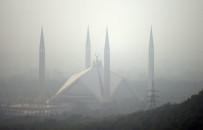Need to rethink flood management
Climate change budgetary allocations remain modest

Pakistan has been hit by major floods again this year. This is not the first time that annual monsoons, supercharged by climate change, have wreaked havoc in the country. Over the past fifteen years alone, this is the third time that Pakistan has experienced catastrophic flooding.
Besides loss of lives, injuries and the havoc caused to the lives of those directly hit by flooding, the indirect effects of widescale floods impact even a larger number of people. The 2022 mega-floods, for instance, adversely affected around 33 million people and caused an estimated $30 billion in economic damage. The earlier mega-floods in 2010 affected over 20 million people and caused economic losses of around $10 billion.
While the losses caused by the current floods will take some time to estimate, already thousands of villages have been evacuated. Major cities like Lahore and Sialkot have suffered serious damage too due to overflow and breaches of the Ravi and Sutlej rivers.
Despite Pakistan being an evident hotspot for major climate-induced disasters, including not only massive floods but also droughts, heat stress and sea water intrusion, efforts needed to contend with these emerging problems remain lackluster.
Pakistan has been making a case for itself via international platforms to secure greater support to deal with climate disasters. Yet, the funds coming into the country via grants or loans are not sufficient to cope with climate induced losses or to enable adequate climate resilience.
At the domestic front, there has been a substantial increase in defence spending after the recent round of hostilities with India. Yet, climate change budgetary allocations remain modest.
Pakistan is also struggling to come up with strategies to respond to India holding in abeyance the Indus Water Treaty, which can compound the country's water insecurity, already at alarming levels due to climate changes, pollution and decades of exploitative water management policies. However, even if the IWT was functioning, India could have done little to stem the flow of the current floods caused by excessive rains, rather than any upper riparian misadventure.
India did use diplomatic channels to warn Pakistan when it began releasing water from upstream dams on rivers allocated to India. But these last-minute warnings could do little to avert serious damage.
The unfolding destruction to lives, livelihoods and essential infrastructure being caused by these latest floods demonstrates the inadequacy of Pakistan's disaster management mechanisms. Merely investing in more barrages and dams will not enable Pakistan to better contend with climate-induced water threats. The country needs better early-warning systems which share real-time data across different regions, and even with its hostile upper-riparian neighbor, whenever that becomes politically possible.
Moreover, besides relying primarily on increasingly indifferent donors for more support, our policymakers should focus on ensuring implementation of locally relevant climate adaptation strategies. Investing in effective drainage and sewage systems and taking basic measures to climate-proof vital infrastructure to better withstand future flooding events do not require overly-sophisticated technological feats.
Other possibilities to blunt the force of floods include the need to curb reckless deforestation, which seems to be on an upswing again. Stopping encroachment of riverbanks and preventing construction of illegal and unsafe housing projects are also not measures which need international technical or financial support. Yet, effective execution of such measures will imply ignoring and undermining vested interests of those who fill their pockets by enabling such activities.



















COMMENTS (1)
Comments are moderated and generally will be posted if they are on-topic and not abusive.
For more information, please see our Comments FAQ